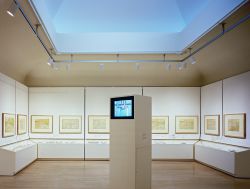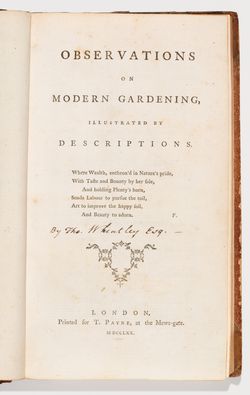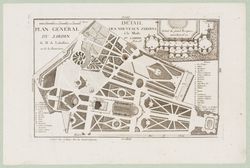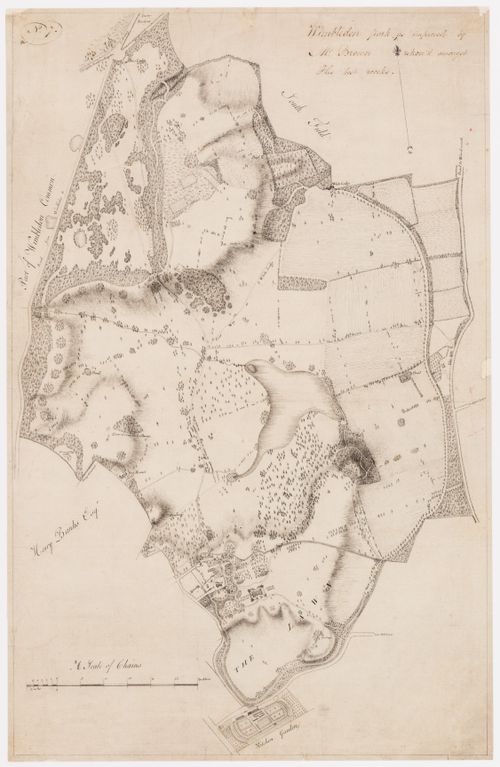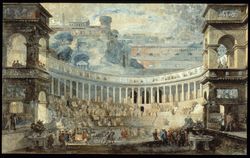*Opening the Gates of Eighteenth-Century Montréal* explores the development of the city during the eighteenth century, when Montréal was a fortified town. The exhibition provides a unique opportunity to consider the building of the eighteenth-century military and commercial town, the nucleus from which Montréal grew. The product of nearly fifteen years of research and(...)
Main galleries
8 September 1992 to 28 February 1993
Opening the Gates of Eighteenth-Century Montréal
Actions:
Description:
*Opening the Gates of Eighteenth-Century Montréal* explores the development of the city during the eighteenth century, when Montréal was a fortified town. The exhibition provides a unique opportunity to consider the building of the eighteenth-century military and commercial town, the nucleus from which Montréal grew. The product of nearly fifteen years of research and(...)
Main galleries
Jean-Marie Moral, l`architecte-paysagiste, Transformation of the Garden, Eighteenth Century, Visiting Scholar
15 March 2002
photographs
AP140.S2.SS1.D38.P4
Description:
views of publications drawings, views of a freehand perspective for the Civic Centre and of a sketch for the shopping arcade used to illustrate the published project, and which are not otherwise present in the file, views of the eighteenth-century façade of the Derby Assembly Rooms, aerial views of the historic centre of Derby used to illustrate the published project
Views of publications drawings
Actions:
AP140.S2.SS1.D38.P4
Description:
views of publications drawings, views of a freehand perspective for the Civic Centre and of a sketch for the shopping arcade used to illustrate the published project, and which are not otherwise present in the file, views of the eighteenth-century façade of the Derby Assembly Rooms, aerial views of the historic centre of Derby used to illustrate the published project
photographs
Project
AP178.S1.1990.PR09
Description:
The project series documents the Recuperação do Restaurante Pai Ramiro in Porto, Portugal. While the records were held in the office’s archives this project was assigned the number 19/90. The office assigned the dates 1990-1994 for this project. This project consists of a design for the restaurant Pai Ramiro in an existing eighteenth-century home. The restaurant was to have a capacity of 36 people, with a waiting bar, kitchen, storage spaces and a second-floor terrace. The building program proposed a bar area flooded in natural light from windows that revealed a backyard garden. The installation of air conditioning, a fire detection system and ventilation systems were also proposed. This project was not built. The project is recorded through drawings, photographic materials and some textual records dating from 1989-1995. The drawings include sketches, plans, elevations, sections, perspectives, details and framing drawings, while the photographic materials largely document the exisiting building. The textual records consist of correspondence, permit and supplier documentation, and the electrical program.
1989-1995
Recuperação do Restaurante Pai Ramiro [Pai Ramiro restaurant renovations], Porto, Portugal (1990-1994)
Actions:
AP178.S1.1990.PR09
Description:
The project series documents the Recuperação do Restaurante Pai Ramiro in Porto, Portugal. While the records were held in the office’s archives this project was assigned the number 19/90. The office assigned the dates 1990-1994 for this project. This project consists of a design for the restaurant Pai Ramiro in an existing eighteenth-century home. The restaurant was to have a capacity of 36 people, with a waiting bar, kitchen, storage spaces and a second-floor terrace. The building program proposed a bar area flooded in natural light from windows that revealed a backyard garden. The installation of air conditioning, a fire detection system and ventilation systems were also proposed. This project was not built. The project is recorded through drawings, photographic materials and some textual records dating from 1989-1995. The drawings include sketches, plans, elevations, sections, perspectives, details and framing drawings, while the photographic materials largely document the exisiting building. The textual records consist of correspondence, permit and supplier documentation, and the electrical program.
Project
1989-1995
Series
Articles, 2015-2020
AP133.S3
Description:
This series documents Pierre du Prey's writings for articles in collaborative publications and magazine on the history of architecture. It contains documents related to the following articles: "William Chambers, John Yenn, and the Boboli Gardens transported to England's Shores" in "Rethinking Renaissance Drawings: Essays in Honour of David McTavish" edited by Una Roman d’Elia (2015); "Conviviality Versus Seclusions in Pliny’s Tuscan and Laurentine Villas" in "The Roman Villa in the Mediterranean Bassin: Late Republic to Late Antiquity" edited by Annalisa Marzano and Guy P. R. Métraux (2017); and "London, Parma, Dresden: Exposition, Competition, Exhibition" in "The Companions to the History of Architecture, Volume II: Eighteenth-Century Architecture", edited by Caroline van Eck and Sigrid de Jong (2018). It also contains material related to the article "A Serendipitous Discovery" published in "The Architectural Historian" magazine of March 2019 about a recently found drawing by Sir John Soane and small publication "Finding the 'Lost' Church of St. John the Baptist" published by Delusso Éditeur in 2020. The series contains draft and final versions of texts, and correspondence regarding each of the five articles.
2010-2020
Articles, 2015-2020
Actions:
AP133.S3
Description:
This series documents Pierre du Prey's writings for articles in collaborative publications and magazine on the history of architecture. It contains documents related to the following articles: "William Chambers, John Yenn, and the Boboli Gardens transported to England's Shores" in "Rethinking Renaissance Drawings: Essays in Honour of David McTavish" edited by Una Roman d’Elia (2015); "Conviviality Versus Seclusions in Pliny’s Tuscan and Laurentine Villas" in "The Roman Villa in the Mediterranean Bassin: Late Republic to Late Antiquity" edited by Annalisa Marzano and Guy P. R. Métraux (2017); and "London, Parma, Dresden: Exposition, Competition, Exhibition" in "The Companions to the History of Architecture, Volume II: Eighteenth-Century Architecture", edited by Caroline van Eck and Sigrid de Jong (2018). It also contains material related to the article "A Serendipitous Discovery" published in "The Architectural Historian" magazine of March 2019 about a recently found drawing by Sir John Soane and small publication "Finding the 'Lost' Church of St. John the Baptist" published by Delusso Éditeur in 2020. The series contains draft and final versions of texts, and correspondence regarding each of the five articles.
Series
2010-2020
DR1985:0415
Description:
- DR1985:0415 presents a cartographic survey of Wimbledon Park as "improved" in the second half of the eighteenth century. Covering some 1,200 acres, the park as shown in this plan contains all the elements of Capability Brown's mature landscape style: expanses of grass traversed by meandering paths, irregular plantings of trees placed singly and in clumps, and winding streams dammed to create a large, irregular lake near the centre of the property and several small ponds about the periphery. The main house (built 1732-33 for Sarah, the Duchess of Marlborough), its outbuildings, and the village church are shown at the southern end of the park, as is a kitchen garden dating from an earlier period. Roads, lanes, and neighbouring properties are neatly labelled in the draughtsman's hand, and the fall of the land has been indicated in shade lines.
landscape architecture, topographic
between 1765 and 1785
A survey plan of Wimbledon Park as designed for Lord Spencer by Capability Brown
Actions:
DR1985:0415
Description:
- DR1985:0415 presents a cartographic survey of Wimbledon Park as "improved" in the second half of the eighteenth century. Covering some 1,200 acres, the park as shown in this plan contains all the elements of Capability Brown's mature landscape style: expanses of grass traversed by meandering paths, irregular plantings of trees placed singly and in clumps, and winding streams dammed to create a large, irregular lake near the centre of the property and several small ponds about the periphery. The main house (built 1732-33 for Sarah, the Duchess of Marlborough), its outbuildings, and the village church are shown at the southern end of the park, as is a kitchen garden dating from an earlier period. Roads, lanes, and neighbouring properties are neatly labelled in the draughtsman's hand, and the fall of the land has been indicated in shade lines.
landscape architecture, topographic
archives
Level of archival description:
Fonds
AP051
Synopsis:
The Groupe de recherche sur Montréal fonds, 1975-1997, documents the Groupe de recherche sur Montréal’s (GRM) extensive research on the development of pre and post-industrial Montreal’s built environment. In addition to this extensive collection of research materials, the fonds also includes administrative files relating to the GRM’s everyday administration and management. Materials found in this fonds consist of approximately 40 l.m. of textual documentation, approximately 2000 maps and 1 model.
1975-1997
Groupe de recherche sur Montréal fonds
Actions:
AP051
Synopsis:
The Groupe de recherche sur Montréal fonds, 1975-1997, documents the Groupe de recherche sur Montréal’s (GRM) extensive research on the development of pre and post-industrial Montreal’s built environment. In addition to this extensive collection of research materials, the fonds also includes administrative files relating to the GRM’s everyday administration and management. Materials found in this fonds consist of approximately 40 l.m. of textual documentation, approximately 2000 maps and 1 model.
archives
Level of archival description:
Fonds
1975-1997
During the eighteenth century, Rome was both an important centre for Italian art and the focal point for the studies of most European artists; all were drawn by the city’s antique art, architecture, and statuary, as well as its Renaissance, Baroque, and eighteenth-century masterpieces. Exploring Rome: Piranesi and His Contemporaries is concerned with eighteenth-century(...)
Main galleries
18 August 1993 to 2 January 1994
Exploring Rome: Piranesi and His Contemporaries
Actions:
Description:
During the eighteenth century, Rome was both an important centre for Italian art and the focal point for the studies of most European artists; all were drawn by the city’s antique art, architecture, and statuary, as well as its Renaissance, Baroque, and eighteenth-century masterpieces. Exploring Rome: Piranesi and His Contemporaries is concerned with eighteenth-century(...)
Main galleries
archives
Level of archival description:
Fonds
Joseph Rykwert fonds
AP209
Synopsis:
The Joseph Rykwert fonds, 1928-2022, documents Joseph Rykwert’s career as an architectural historian, author and professor. The fonds includes the records for over a dozen monographs written between the mid-1960s and the mid-2010s as well as edited works and articles, and details his teaching and lecturing activities from the 1960s onwards in universities in Europe and the United States. The records highlight Joseph Rykwert’s multidisciplinary approach, which involved archaeology, anthropology and psychoanalysis in his study of the history and theory of architecture and of the urban form. The fonds is composed of textual records, publications and ephemera, and of photographs including multiple albums and a large number of slides; the fonds also documents Joseph Rykwert’s career as an independent designer through drawings realized between the late 1940s and the late 1970s.
1928-2022
Joseph Rykwert fonds
Actions:
AP209
Synopsis:
The Joseph Rykwert fonds, 1928-2022, documents Joseph Rykwert’s career as an architectural historian, author and professor. The fonds includes the records for over a dozen monographs written between the mid-1960s and the mid-2010s as well as edited works and articles, and details his teaching and lecturing activities from the 1960s onwards in universities in Europe and the United States. The records highlight Joseph Rykwert’s multidisciplinary approach, which involved archaeology, anthropology and psychoanalysis in his study of the history and theory of architecture and of the urban form. The fonds is composed of textual records, publications and ephemera, and of photographs including multiple albums and a large number of slides; the fonds also documents Joseph Rykwert’s career as an independent designer through drawings realized between the late 1940s and the late 1970s.
archives
Level of archival description:
Fonds
1928-2022
